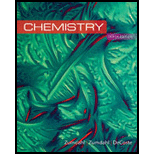
Concept explainers
(a)
Interpretation:
The complex ion, the counter ions, the electronic configuration of the
Concept introduction:
The electrons in the d orbital of a transition metal split into high and low energy orbitals when ligands are attached to it. The energy difference between these two levels depends upon the properties of both metal and the ligands. If the ligand is strong, then splitting will be high and the complex will be low spin. If the ligand is weak, then splitting will be less and the complex will be high spin.
To determine: The complex ion, the counter ions, the electronic configuration of the transition metal and geometry of complex ion for the given coordination compound.
(a)
Answer to Problem 74AE
The complex ion present is
Explanation of Solution
The given compound is
The coordination compound is
The bracket indicates the composition of complex ion; hence, the complex ion present is
The counter ions are
The oxidation state of cobalt is assumed to be
The number of water ligands is
Substitute the values of number of cobalt atoms, water ligands and charge on them in the above equation,
Therefore, oxidation state of cobalt is
Electronic configuration of
The
Therefore, the geometry of the complex ion is octahedral.
(b)
Interpretation:
The complex ion, the counter ions, the electronic configuration of the transition metal and geometry of complex ion for each of the given coordination compounds is to be stated.
Concept introduction:
The electrons in the d orbital of a transition metal split into high and low energy orbitals when ligands are attached to it. The energy difference between these two levels depends upon the properties of both metal and the ligands. If the ligand is strong, then splitting will be high and the complex will be low spin. If the ligand is weak, then splitting will be less and the complex will be high spin.
To determine: The complex ion, the counter ions, the electronic configuration of the transition metal and geometry of complex ion for the given coordination compound.
(b)
Answer to Problem 74AE
The complex ion present is
Explanation of Solution
The dissociation reaction of
The bracket indicates the composition of complex ion hence the complex ion present is
The counter ions are
The oxidation state of silver is assumed to be
The number of
The number of silver atom is
Substitute the values of number of silver atoms,
Therefore, oxidation state of silver is
Electronic configuration of
Therefore, the geometry of the complex ion is tetrahedral.
(c)
Interpretation:
The complex ion, the counter ions, the electronic configuration of the transition metal and geometry of complex ion for each of the given coordination compounds is to be stated.
Concept introduction:
The electrons in the d orbital of a transition metal split into high and low energy orbitals when ligands are attached to it. The energy difference between these two levels depends upon the properties of both metal and the ligands. If the ligand is strong, then splitting will be high and the complex will be low spin. If the ligand is weak, then splitting will be less and the complex will be high spin.
To determine: The complex ion, the counter ions, the electronic configuration of the transition metal and geometry of complex ion for the given coordination compound.
(c)
Answer to Problem 74AE
The complex ion present is
Explanation of Solution
The dissociation reaction of
The bracket indicates the composition of complex ion hence the complex ion present is
The counter ion is
The oxidation state of copper is assumed to be
The number of
The number of
Substitute the values of number of
Therefore, oxidation state of
Electronic configuration of
Therefore, the geometry of the complex is tetrahedral.
Want to see more full solutions like this?
Chapter 21 Solutions
Chemistry
- The reaction Q(g) + R(g) → Z(l) is shown to be exothermic. Which of the following is true concerning the reactionarrow_forwardWhich of the following has the largest standard molar entropy, S° (298.15 K) He H2 NaCl KBr Hgarrow_forwardWhich of the following is true for a particular reaction if ∆G° is -40.0 kJ/mol at 290 K and –20.0 kJ/mol at 390 K?arrow_forward
- Choose the major product of the reaction with correct regio- and stereochemistry. Br2 H₂O O "Br Br & O 'Br OH Br 吡 O OH OH Br "OH Brarrow_forwardSelect the major product of the following reaction. & Br (CH)CONa (CH₂),COH 0 OC(CH) O &arrow_forwardDraw the products of the hydrolysis reaction between the ester molecule and water. Determine the products of the following reaction.arrow_forward
 Chemistry & Chemical ReactivityChemistryISBN:9781337399074Author:John C. Kotz, Paul M. Treichel, John Townsend, David TreichelPublisher:Cengage Learning
Chemistry & Chemical ReactivityChemistryISBN:9781337399074Author:John C. Kotz, Paul M. Treichel, John Townsend, David TreichelPublisher:Cengage Learning Chemistry: The Molecular ScienceChemistryISBN:9781285199047Author:John W. Moore, Conrad L. StanitskiPublisher:Cengage Learning
Chemistry: The Molecular ScienceChemistryISBN:9781285199047Author:John W. Moore, Conrad L. StanitskiPublisher:Cengage Learning ChemistryChemistryISBN:9781305957404Author:Steven S. Zumdahl, Susan A. Zumdahl, Donald J. DeCostePublisher:Cengage Learning
ChemistryChemistryISBN:9781305957404Author:Steven S. Zumdahl, Susan A. Zumdahl, Donald J. DeCostePublisher:Cengage Learning Chemistry: An Atoms First ApproachChemistryISBN:9781305079243Author:Steven S. Zumdahl, Susan A. ZumdahlPublisher:Cengage Learning
Chemistry: An Atoms First ApproachChemistryISBN:9781305079243Author:Steven S. Zumdahl, Susan A. ZumdahlPublisher:Cengage Learning
 Chemistry: Principles and ReactionsChemistryISBN:9781305079373Author:William L. Masterton, Cecile N. HurleyPublisher:Cengage Learning
Chemistry: Principles and ReactionsChemistryISBN:9781305079373Author:William L. Masterton, Cecile N. HurleyPublisher:Cengage Learning





